| Oracle® Database Storage Administrator's Guide 11g Release 1 (11.1) Part Number B31107-01 |
|
|
View PDF |
| Oracle® Database Storage Administrator's Guide 11g Release 1 (11.1) Part Number B31107-01 |
|
|
View PDF |
This chapter describes how to administer Automatic Storage Management (ASM) by using Oracle Enterprise Manager to provision and manage datafile storage. This chapter contains the following topics:
All ASM administration tasks begin with the Automatic Storage Management Home page in Enterprise Manager, shown in Figure 6-1. The Automatic Storage Management Home page displays:
The status of the ASM instance
A chart that shows the used and free space of each disk group and disk group internal usage
A list of databases that are serviced by the ASM instance
Links to the ASM Performance, Disk Groups, Configuration, and Users pages
Figure 6-1 Automatic Storage Management Home Page
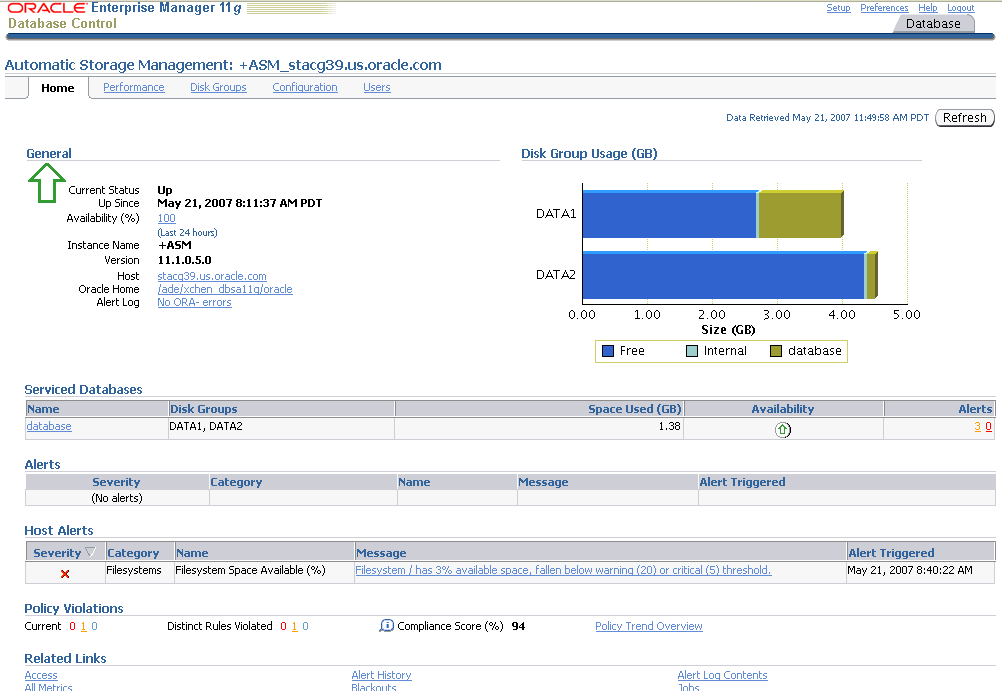
To access the Automatic Storage Management Home page on a single instance system:
Access the Database Home page by logging in as any database user.
See Also:
Oracle Database 2 Day DBA for more informationUnder the heading labeled General on the left side of the Database Instance Home page as shown in Figure 6-1, click the link next to the last entry in the General column labeled ASM.
If prompted for ASM login credentials, then enter the user SYS, provide the SYS password that was set for the ASM instance upon installation, and connect as SYSASM. Enterprise Manager displays the Automatic Storage Management Home page similar to the page in Figure 6-1.
See Also:
"Authentication for Accessing ASM Instances" for more information about authenticationTo access the Automatic Storage Management Home page in an Oracle Real Application Clusters (RAC) environment:
Log in to Enterprise Manager Database Control on any node that is running the Oracle Management Service (OMS).
OMS is automatically started on the node on which Database Configuration Assistant (DBCA) was originally run to create the cluster database. Depending on your configuration, OMS might also be running on other nodes.
See Also:
Oracle Database 2 Day + Real Application Clusters Guide for more informationOn the Cluster Database page, under the Instances heading, click the link for the ASM instance that you want to access.
You can configure ASM with the Enterprise Manager Configuration Parameters page similar to the one shown in Figure 6-2.
Figure 6-2 Automatic Storage Management Configuration Parameters Page
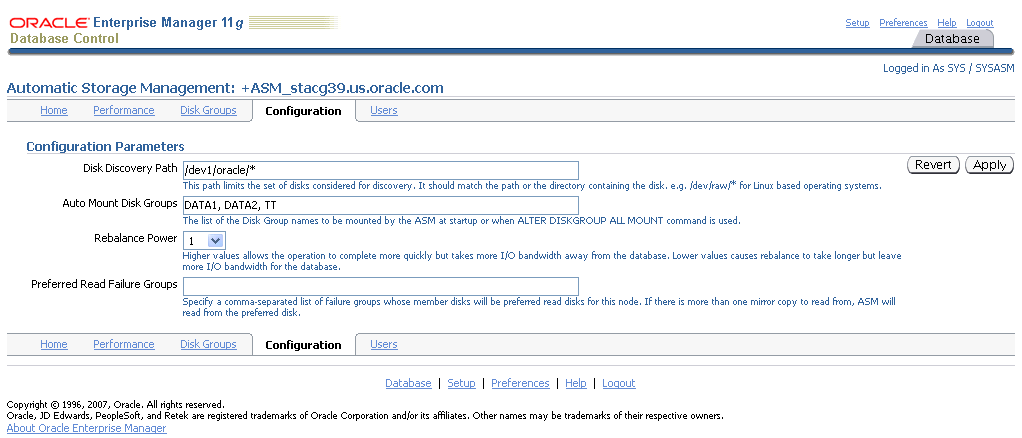
To configure the ASM instance:
Access the Automatic Storage Management Home page.
See "The Automatic Storage Management Home Page" for instructions.
Click the Configuration link at the top of the page to view the Configuration Parameters page.
Update the configuration options on the page:
Disk Discovery Path (ASM_DISKSTRING initialization parameter)
Enter a string value. See "ASM_DISKSTRING".
Auto Mount Disk Groups (ASM_DISKGROUPS initialization parameter)
Enter a string value. See "ASM_DISKGROUPS".
Rebalance Power (ASM_POWER_LIMIT initialization parameter)
Enter an integer value. See "ASM_POWER_LIMIT".
Preferred Read Failure Groups (Only in Oracle RAC environments) (ASM_PREFERRED_READ_FAILURE_GROUPS initialization parameter)
Enter a comma-separated string of values in which each string represents a failure group. This parameter is generally used only for clustered ASM instances. See "ASM_PREFERRED_READ_FAILURE_GROUPS".
Click Apply to save your changes or click Revert to discard any changes made on the page.
Perform the following procedures to bring a disk online or offline:
Access the Automatic Storage Management Home page.
See "The Automatic Storage Management Home Page" for instructions.
Click the Disk Groups link at the top of the page to view the Disk Groups page. Enterprise Manager displays a page similar to the one show in Figure 6-3.
Figure 6-3 Automatic Storage Management Disk Groups List Page
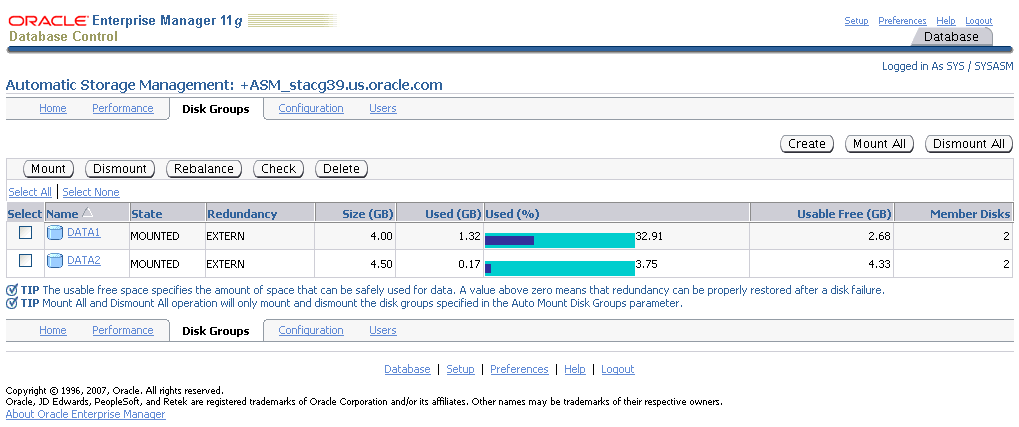
Click the name of a disk in the Name column and Enterprise Manager displays the General page for the disk group that you want to modify. The General page that you see should be similar to the one shown in Figure 6-4.
Figure 6-4 Automatic Storage Management Disk Group Details Page
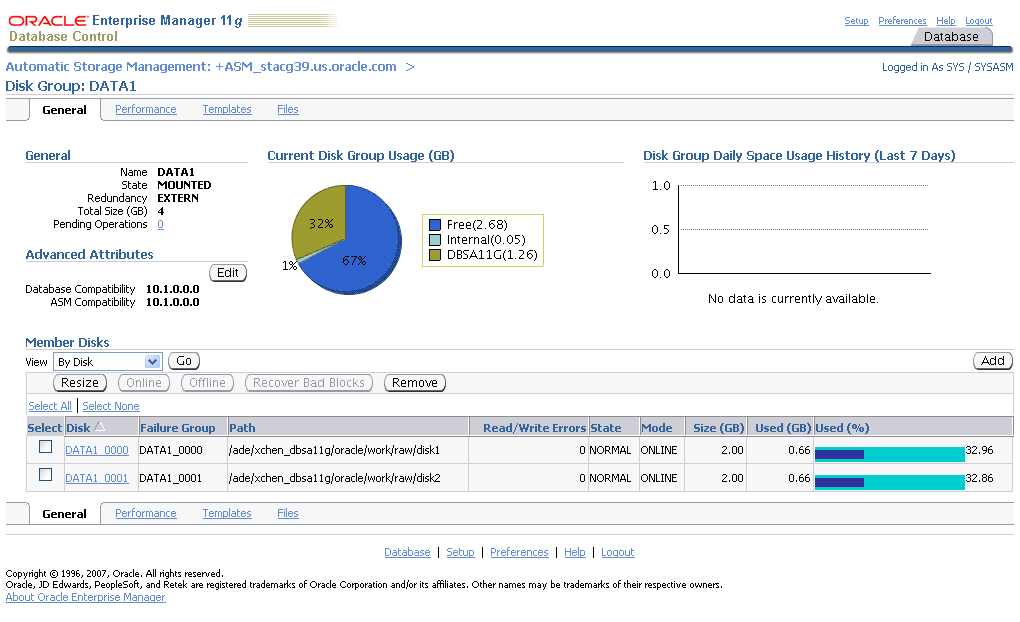
To bring a disk online, select the disk that you want to bring online and click Online. Note that if you bring a disk online, then ASM performs the following:
ASM performs the online operation on the selected disks. You can select one or more or disks, or all of the disks to bring online. If you select all of the disks, then Oracle uses the ALL keyword for this operation. Otherwise, only the selected disks are affected by the online operation.
During the online process, Enterprise Manager first places a disk into online mode to accommodate write operations. Then Enterprise Manager resynchronizes stale data on the disk with the current data until the disk is fully online for read operations; this is the ASM fast mirror resync feature.
You can also choose the By Failure Group view to perform this operation on a selected disk group. In this case, Oracle uses the SQL for disks in failure group.
You can also select a disk that is already online, but Enterprise Manager ignores that selection and only brings disks online that were previously offline.
Click Yes on the Enterprise Manager Confirmation dialog to begin bringing the disk online or click No to cancel the operation. You can also click Show SQL to review the SQL that Enterprise Manager uses for the online operation.
To take a disk offline, select the disk that you want to take offline and click Offline. Note that if you bring a disk offline, then ASM performs the following:
Depending on how much data is stale, the operation may require additional time to complete. You can monitor the operation's progress using the Pending Operations link from the Disk Group Home page.
The value that you set for Rebalance Power using ASM_POWER_LIMIT must be a whole number ranging from 0 to 11, inclusively. Note the text on the page that describes how the value of Rebalance Power affects the fast mirror resync operation. If the ASM_POWER_LIMIT is set to 0, then ASM does not perform automatic rebalance.
By default, the Rebalance Power value uses the value of the ASM_POWER_LIMIT initialization parameter.
Enterprise Manager displays an Offline Confirmation page and the text on this page explains that after Enterprise Manager takes the selected disks offline, the ASM instance waits for the period of time that is specified by the value that you have set for the DISK_REPAIR_TIME initialization parameter before ASM drops the disks. During the disk repair time period, you can repair the disks and then place them back online. For each disk that you successfully place online, the pending drop operation is canceled and a resynchronization operation begins.
If you have set DISK_REPAIR_TIME to a large value, for example, greater than one day, then this increases the possibility of data loss. This is because the files in the disk group are protected with a lower degree of redundancy during this period.
Click Yes on the Enterprise Manager Conformation dialog to begin the offline processing or click No to stop the operation. You can also click Show SQL to see the SQL that Enterprise Manager uses for the offline operation.
You can manage ASM users with the Enterprise Manager Users page, shown in Figure 6-5. Access this page by clicking the Users tab that is near the top center of the Automatic Storage Management Home page.
Figure 6-5 Automatic Storage Management Users Dialog

Access the Automatic Storage Management Home page.
See "The Automatic Storage Management Home Page" for instructions.
Click the Users link at the top to view the Users property page.
Click Create to add a new ASM user. When you add users, Enterprise Manager displays a Create User page in which you must enter user login credentials that include the user name, password, and password confirmation. You can also grant privileges to the new user by selecting privileges in the Available Privileges column and clicking the right arrow buttons to move privileges to the Granted Privileges column, or move the privilege by double clicking it. The available privileges include SYSDBA, SYSOPER, and SYSASM. Click OK to create the user, Cancel to cancel the procedure, or Show SQL to view the SQL that Enterprise Manager uses to create the user.
To edit a user's properties, click the check box in the Select column for the user that you want to edit and click Edit. On the Edit User page, modify the password if needed. You can also alter the privileges that are assigned to the user by selecting the privilege and using the right and left arrow buttons to move the privilege from the Granted Privileges column to the Available Privileges column and vice versa. You can also move the privilege by double clicking it. Click OK to edit the user properties, Revert to cancel the procedure, or Show SQL to view the SQL that Enterprise Manager uses to edit the user's properties.
To delete an ASM user, click the check box in the Select column for the user that you want to delete and click Delete. On the confirmation dialog, click Yes to delete the user or No to stop the user deletion procedure.
See Also:
"Authentication for Accessing ASM Instances" for more information about user authenticationThis section describes how to manage disk groups under the following topics:
You can create additional ASM disk groups to:
Have disk groups with different redundancy levels (normal, high, or external), depending on availability requirements and storage system capabilities.
Separate different classes of storage, such as SCSI drives and SATA drives, into different disk groups. Disks in a disk group should have similar size and performance characteristics.
Store the flash recovery area in a separate disk group from the database.
To create a disk group:
Access the Automatic Storage Management Home page.
See "The Automatic Storage Management Home Page" for instructions.
Click the Disk Groups link at the top of the page to display the Disk Groups property page.
If you are not already logged in, then the Log In page appears and you should log in as the SYS user, connecting as SYSASM. Provide the SYS password for the ASM instance. This password was set up when the ASM instance was created.
Click Create and Enterprise Manager displays a Create Disk Group page similar to the page in Figure 6-6. The Create Disk Group page displays a list of ASM disks that are available to be added to a disk group. This includes disks with a header status of CANDIDATE, PROVISIONED, or FORMER, and so on.
Figure 6-6 Automatic Storage Management Create Disk Group Page
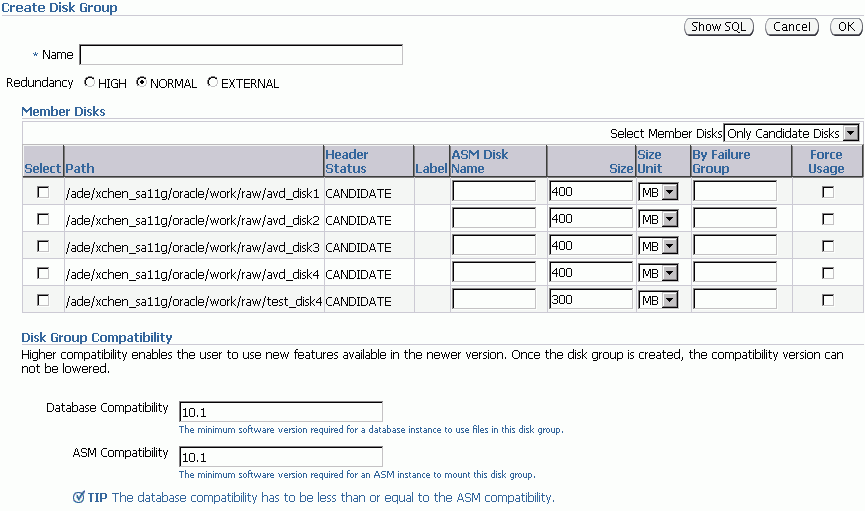
If you want to display not only disks that are available to be added to a disk group, but all ASM disks, including disks that already belong to a disk group (header status = MEMBER), then select All Disks from the Select Member Disks list.
The page is re-displayed with the complete list of ASM disks that were discovered by the ASM instance.
Enter the disk name, select a redundancy type (high, normal, or external), and optionally, you can enter a failure group name.
Select disks as follows:
Select the check box to the left of each disk that you want to include in the new disk group.
If you want to force the inclusion of a disk in the disk group, select the Force Usage check box for that disk.
Caution:
The Force Usage check box causes the disk to be added to the new disk group even if the disk already belongs to another disk group and has valid database data. This data will be lost. You must be certain that you are selecting a disk that can legitimately be added to the disk group. See "Creating Disk Groups" for a discussion of theFORCE option.Specify a Disk Compatibility value for the disk group to enable your system to use the latest ASM features.
Note:
You cannot reverse setting a disk compatibility value.For setting a disk group's database compatibility, the value that you use must be less than or equal to the ASM compatibility. This is the minimum software version that is required for a database instance to use the files in the disk group. If the database compatibility value that you use is greater than the ASM compatibility, then Enterprise Manager displays the following: Error: The database compatibility has to be less or equal to the ASM compatibility. If you enter a value for a lower version than the current version that is in use, then Enterprise Manager displays the error: The version to advance to has to be greater than the current version. By default, both check boxes are checked.
Note:
You cannot modify the database compatibility for an ASM cluster that is in a rolling migration state.For setting a disk group's ASM Compatibility, the value that you use is the minimum software version required for an ASM instance to mount this disk group.
Click OK to create the disk group or click Cancel to stop the disk group creation operation. You can also click Show SQL to show the SQL statements that the disk group creation operation uses.
See Also:
See "Creating Disk Groups" for more information about creating disk groups the Oracle Database Reference description of theV$ASM_DISK view for information about the various header statuses of ASM disksYou can add disks to a disk group to increase the total amount of storage space in a disk group. If you add multiple disks in a single operation, then ASM rebalances the disk group to evenly distribute the data on all disks, including the newly added disks.
You can control the power of a rebalance operation, which is a number from 0 to 11. The higher the number, the faster the rebalance operation completes. Lower numbers cause rebalancing to take longer, but consume fewer processing and I/O resources. This leaves these resources available for the database. The default value of 1 minimizes disruption to the database.
A value of 0 blocks the rebalance operation altogether. Manual or automatic rebalance can then occur at a later time. You might want to postpone rebalancing to wait for a time when there are fewer demands on the database, or to add more disks or drop disks later if you want the rebalancing to be done only once for all of your disk group changes.
See Also:
"Altering Disk Groups" for information about controlling rebalance operationsTo add one or more disks to a disk group:
Access the Automatic Storage Management Home page.
See Also:
"The Automatic Storage Management Home Page" for instructionsClick the Disk Groups link to display the Disk Groups property page.
If the ASM Login page appears, then log in as the SYS user, connecting as SYSASM. Provide the SYS password for the ASM instance. This password was set up when the ASM instance was created.
Click a link in the Name column to select the disk group to which you want to add disks. The Disk Group page similar to the page in Figure 6-7 appears, displaying a list of disks that are already in the disk group.
Figure 6-7 Automatic Storage Management Disk Group Page
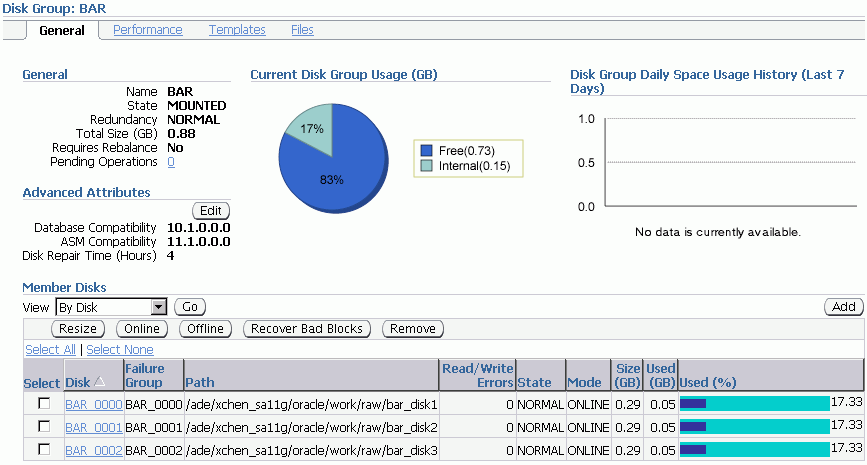
Click Add and Enterprise Manager displays the Add Disks page. This page displays a list of ASM disks that are available to be added to the disk group. This includes disks with the header status of CANDIDATE, PROVISIONED, or FORMER, and so on.
Figure 6-8 Automatic Storage Management Add Disks Page
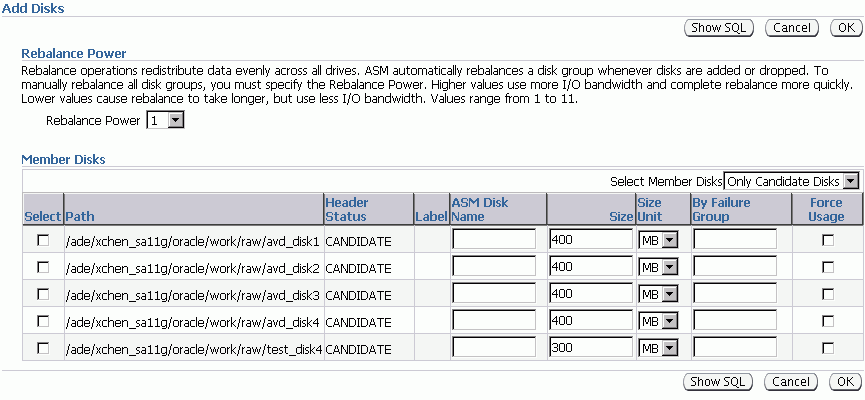
To display not only disks that are available to be added to a disk group, but all of the ASM disks, including disks that already belong to a disk group (header status = MEMBER), select All Disks from the Select Member Disks drop-down list on the right hand side of the page. Enterprise Manager re-displays the page with the complete list of ASM disks that were discovered by the ASM instance.
Optionally change the rebalance power by selecting a value from the Rebalance Power list.
Select disks as follows:
Select the check box to the left of each disk that you want to add to the disk group.
If you want to force the inclusion of a disk in the disk group, select the Force Reuse check box in the right-most column.
Caution:
The Force Reuse check box causes the disk to be added to the disk group even if the disk already belongs to another disk group and has valid database data. This data will be lost. You must be certain that you are selecting a disk that can legitimately be added to the disk group. Refer to "Adding Disks to a Disk Group" for an example of theFORCE option.Optionally enter an ASM disk name for each disk. ASM provides a name if you do not.
Click OK to add the selected disks.
See Also:
"Altering Disk Groups" for more information about modifying disk group propertiesWhen you drop a disk from a disk group, ASM rebalances the disk group by moving all of the file extents from the dropped disk to other disks in the disk group. ASM then releases the disk and you can then add the disk to another disk group or use it for other purposes. You can drop one or more disks in a single operation. You can also optionally set rebalance power for the drop operation. The following is a list of possible reasons for dropping a disk:
A disk is starting to fail and you need to replace it
You want to upgrade a disk
You want to reallocate the disk to a different disk group or reallocate it to a different storage system
Note:
Dropping disks from a disk group only logically deletes the disks from the disk group. It does not delete the disk contents. However, the contents are lost when you add the disk to a new disk group.To drop one or more disks from a disk group:
Access the Automatic Storage Management Home page.
See "The Automatic Storage Management Home Page" for instructions.
Click the Disk Groups link to display the Disk Groups property page.
If the Automatic Storage Management Login page appears, log in as the SYS user, connecting as SYSASM. Provide the SYS password for the ASM instance. This password was set up when the ASM instance was created.
Click a link in the Name column to select the disk group from which you want to drop disks.
The Disk Group page appears.
Under the Member Disks heading, in the Select column, select the check boxes for the disks that you want to drop, and then click Remove.
A confirmation page appears.
If you want to change rebalance power, or if you want set the FORCE option for dropping disks, do the following:
Click Show Advanced Options.
Optionally select the Force option or select a rebalance power in the Rebalance Power list.
Note:
You might need theFORCE option if ASM cannot read from or write to the disk. See "Dropping Disks from Disk Groups" for a discussion of the FORCE option.Click Yes to drop the disks.
The Disk Group page returns, and displays a state of DROPPING for each disk being dropped.
Refresh the page until the dropped disks no longer appear in the disk group.
Caution:
You cannot reuse or disconnect the dropped disks until the drop and rebalance operations are complete. Operations are complete when the dropped disks no longer appear in the disk group.See "Dropping Disks from Disk Groups" for more information, and for other caveats for dropping disks.When you drop a disk group, you delete the disk group and optionally all of its files. You cannot drop a disk group if any of its database files are open. ASM deletes all of the diskgroup contents only if you specify the "including contents" option. After dropping a disk group, you can add its member disks to other disk groups or use them for other purposes.
One reason to drop a disk group is to change the redundancy level (normal, high, or external). Because you cannot change the redundancy of a disk group, you must drop the disk group and then re-create it with the proper redundancy. In this case, you must back up or move disk group data before you drop the disk group.
To drop a disk group:
Access the ASM Home page.
See Also:
"The Automatic Storage Management Home Page" for instructions about how to access the Automatic Storage Management Home pageClick the Disk Group tab to display the Disk Groups page.
If the ASM Login page appears, log in as the SYS user, connecting as SYSASM. Provide the SYS password for the ASM instance. This password was set up when the ASM instance was created.
Click the check box in the Select column to select a disk group that you want to drop.
Click Delete and confirmation page appears.
If you want to delete the disk group even if it still contains files, click Show Advanced Options and ensure that the Including Contents option is selected. If the disk group contains files and the Including Contents option is not selected, then you cannot drop the disk group.
To delete a disk group that belongs to a disk group that you cannot mount, use the FORCE option in the Advanced Options confirmation dialog. The FORCE option applies to the DISMOUNTED disk group only. This option enables you to delete a disk header and mark it as "former".
Caution:
Use extreme care when using theFORCE option because the ASM instance does not verify whether the disk group is used by any other ASM instance before ASM deletes the disk group.On the confirmation page, click Yes.
See Also:
"Dropping Disk Groups" for more information about dropping disksPerform the following procedures to monitor disk group usage:
To view ASM disk group usage and free space:
Access the Automatic Storage Management Home page.
See Also:
"The Automatic Storage Management Home Page" for instructions about how to access the home pageClick the Disk Groups link to view the Disk Groups property page.
If the ASM Login page appears, then log in as the SYS user, connecting as SYSASM. Provide the SYS password that was set up for ASM when the ASM instance was created.
The Disk Group list page, similar to the page shown in Figure 6-3, displays all of the disk groups and their space usage information.
The Usable Free column displays the space in megabytes that is actually available in the disk group. The values in this column take into account the redundancy level of the disk group, and exclude the space that the disk group reserves for restoring full redundancy for all files in the disk group after a disk failure.
Use the FORCE option to mount a disk group when there are missing disks or missing failure groups. This enables you to correct configuration errors, such as incorrect values for ASM_DISKSTRING without incurring unnecessary rebalance operations. Disk groups mounted with the FORCE option have one or more disks offline if the disks were not available at the time of the mount. You must take corrective action to restore those devices before the time set with the DISK_REPAIR_TIME value expires. Failing to restore and put those disks back online within the disk repair time frame results in ASM automatically removing the disks from the disk group. This would then require a rebalance operation to restore redundancy for all of the files in the disk group. Perform the following procedures to mount a disk with the FORCE option:
From the ASM home page click the Disk Groups tab.
Select the disk group that has a disk that you need to repair and click Dismount. Click OK on the Dismount confirmation dialog. The State column of the Disk Group home page should show the Status as DISMOUNTED.
Perform any needed repairs to the disk in the disk group.
Click the check box in the Select column next to the disk that you want to force mount and click Mount.
On the Disk Mount Confirmation dialog, click the Show Advanced Options link.
On the Mount Force Confirmation dialog as shown inFigure 6-9, select the Force option and click Yes. You can also click No to cancel the mount force operation and Show SQL to review the SQL that Enterprise Manager uses to perform the mount force operation.
Figure 6-9 Mount Force Confirmation Dialog
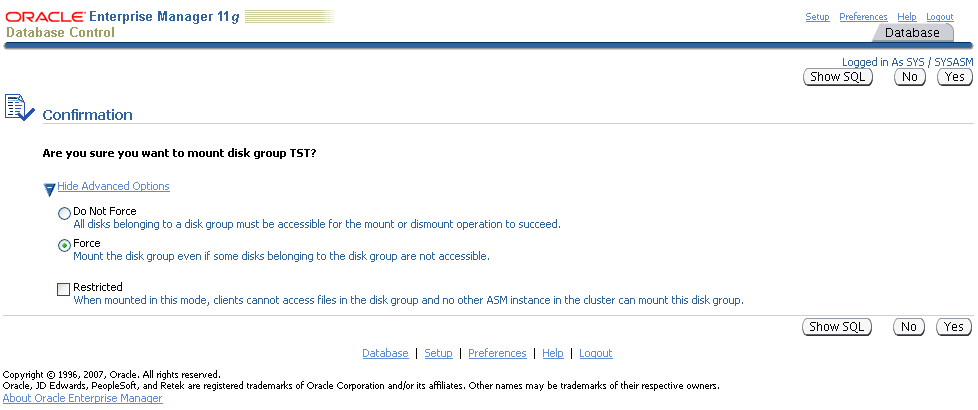
This section explains how to administer advanced disk group properties under the following topic:
Perform the following steps to change the value for the ASM_DISK_REPAIR_TIME parameter:
On the Automatic Storage Disk Group List page, click a disk group name and Enterprise Manager displays the Disk Group Home page.
Click Edit under the Advanced Attributes section, enter a disk repair time value, and click Apply.
You can manage disk group templates with the Enterprise Manager Templates page, shown in Figure 6-10.
Figure 6-10 Automatic Storage Management Templates Page
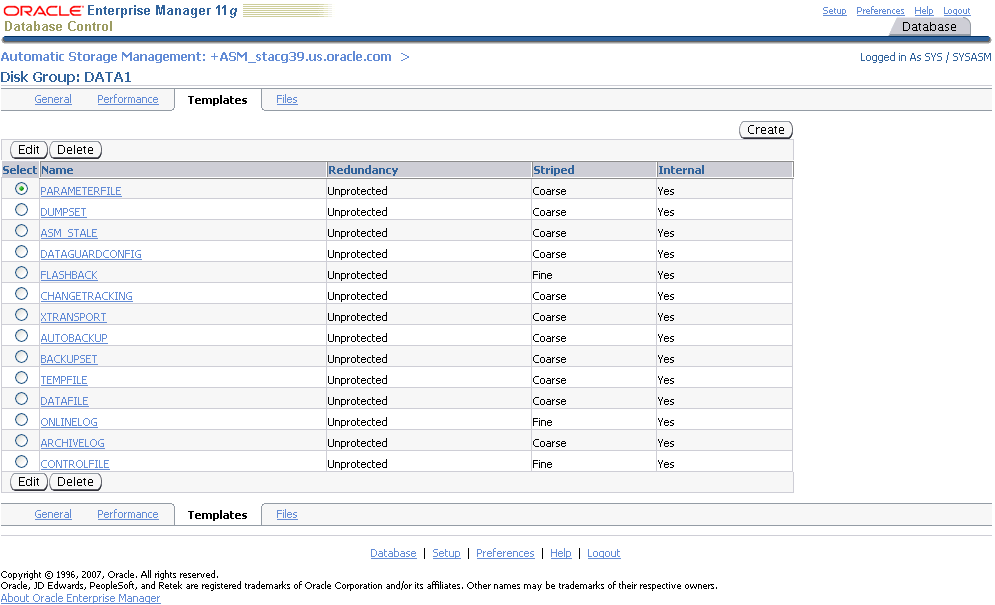
Access the Automatic Storage Management Home page.
See "The Automatic Storage Management Home Page" for instructions.
Click the Disk Groups link to display the Disk Groups property page.
Click a link in the Name column to select a disk group.
Click the Templates link to display the Templates page.
You can click Create to add a new template, click Edit to change a page, or click Delete to remove a template.
If you click Create, then the Create Template page displays and you can enter a name in the Template Name field. You can also specify a Redundancy level and Striped granularity.

This section describes how to perform the following performance-related ASM administrative tasks:
You can monitor ASM performance with the Enterprise Manager Performance page, shown in Figure 6-11.
Figure 6-11 Automatic Storage Management Performance Page
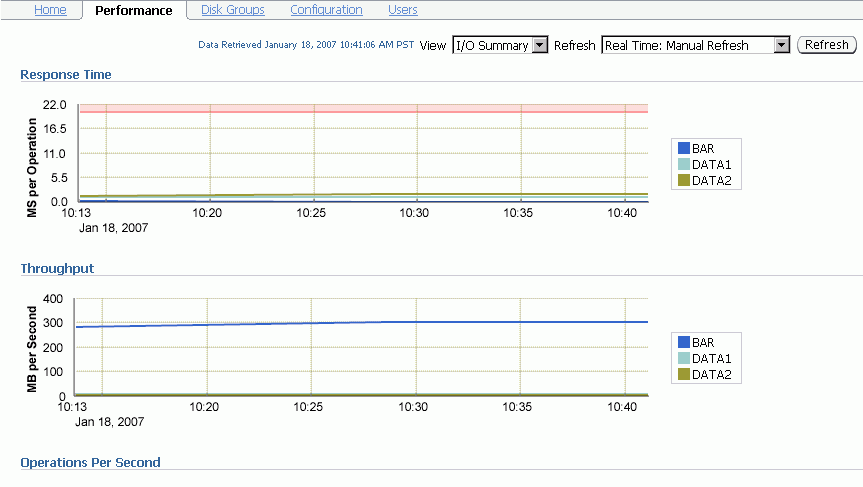
Access the Automatic Storage Management Home page.
See Also:
"The Automatic Storage Management Home Page" for more information about accessing the home pageClick the Performance link to view the Performance property page.
Determine the view and refresh rate of the performance graphs with the View and Refresh options. Click Refresh to manually refresh the graphs. The refresh option has the following two intervals:
Manual refresh: manual, 15 second interval, 30 second interval
Historical data: Last 24 hours, last 7 days, last 31 days
When you check the integrity of ASM disk groups, Enterprise Manager performs consistency checks on all of the disk group metadata. If ASM detects errors, then ASM stores information about errors in the alert log. To check disk groups, perform the following steps:
From the Disk Groups Administration page click Check and ASM displays a confirmation dialog for the check disk group operation.
Figure 6-12 Automatic Storage Management Check Diskgroup Confirmation Dialog
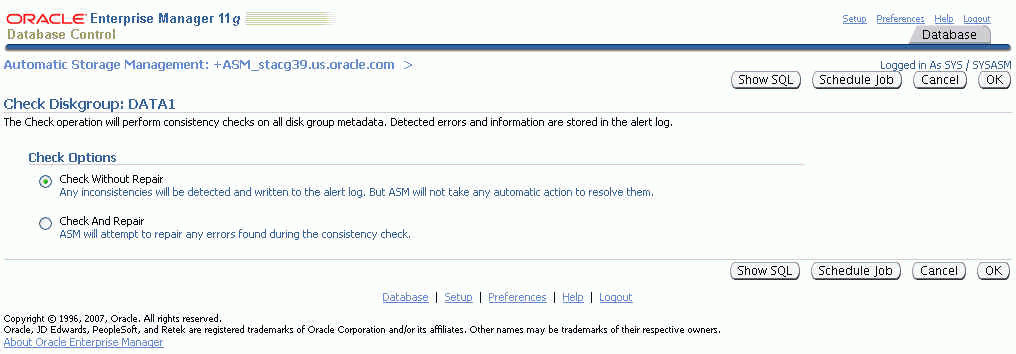
Select Check Without Repair if you only want ASM to record information about disk group inconsistencies in the alert log. In this operation, ASM will not resolve the errors. Select Check And Repair if you want ASM to attempt to repair errors that Enterprise Manager identifies during the disk group consistency check.
Click Yes to start the disk group check operation or No to cancel it. You can also select Show SQL to review the SQL statements that the disk group check operation uses. Click OK to run the check operation as a command. To schedule a job, click Schedule Job. Optionally, you can modify or re-enter the job name and description. Also provide host credentials and enter the scheduling options by selecting Immediately or Later and modifying the date and time as needed. Click OK to schedule the job or Cancel to terminate the job creation process.
Oracle recommends that you use RMAN to back up files managed by ASM. The procedures for using RMAN are documented in Oracle Database 2 Day DBA.
You can also back up your ASM-managed files by performing a files related operation using the following procedures:
Create an alias.
Create a directory
Delete the alias and directory.
Rename the alias and directory
See Also:
For additional information about RMAN, refer to the Oracle Database Backup and Recovery User's Guide.The procedures that you use in Enterprise Manager to perform bad block recovery correspond to the steps that you could manually perform with the remap command using the ASM Command utility (ASMCMD). Use the following procedures to perform bad block recovery:
Go to the Automatic Storage Management home page.
Click the Disk Groups link at the top of the page.
If you are not already logged in, then the Log In page appears and you should log in as the SYS user, connecting as SYSASM. Provide the SYS password for the ASM instance. This password was set up when the ASM instance was created.
Click one of the disk group names and Enterprise Manager displays the disk group home page for that disk group.
Click a box in the Select column to the left of a disk for which you want to recover bad blocks and click Recover Bad Blocks.
Note:
You can only recover bad blocks for disk groups that you have configured with normal or high redundancy; you cannot use this feature for disk groups that you have configured with external redundancy.This section explains how to use Enterprise Manager to migrate your database storage to use ASM. Perform the following steps to migrate to ASM:
At the top of the Enterprise Manager Database Instance Home Page, click the link labeled Server. Enterprise Manager displays Database Server Page.
On the top left-hand side of the Database Server Page under the Storage heading, click the link labeled Migrate to ASM.
If prompted for ASM login credentials, then enter the user SYS, provide the SYS password that was set for the ASM instance upon installation, and connect as SYSDBA. Enterprise Manager displays the Migrate Database To ASM: Migration Options Page.
See Also:
"Authentication for Accessing ASM Instances" for more information about authenticationOn the Migrate Database To ASM: Migration Options Page, which is the first step in a four-step process, verify the information about the files that you want to migrate to ASM. If the target database is in ARCHIVELOG mode, then you could perform online or offline migration by selecting the corresponding radio button. Otherwise, using offline migration is the default. If you perform an online migration, then you can suspend the migration by selecting the checkbox next to Suspend Migration Job Before Switching Database To ASM. Additionally, you can enter an email address to which Enterprise Manager sends a message to notify you about the suspension. By default on this page, the Recovery-related Files option is selected. Deselect this option if you do not want to use it. Also verify the entry for the initialization parameter file. Lastly, the Parallelize File Copy Operations option is selected by default. Deselect this if you do not want Enterprise Manager to perform copy operations in parallel. Click Next when you complete your selections on this page and Enterprise Manager displays the Migrate Database To ASM: Disk Group Options page.
On the Disk Group Options page under Database Area, verify the location where ASM should create datafiles, temporary files, redo log files, and control files. Also verify the Flash Recovery Area where ASM should create the recovery-related files such as archived redo log files, backup files, and so on. Also under Flash Recovery Area, the option for Setup Flash Recovery Area without Migrating Recovery-related Files is selected by default. If needed, change the selection to migrate the files. Click Next when you complete your selections on the Disk Group Options page.
If you chose to use a Flash Recovery Area and Enterprise Manager displays a warning that the available space on the disk group is less than the specified Flash Recovery Area size for the migration, then you can either continue by clicking Yes, or click No to stop the operation and modify your storage.
When you continue, Enterprise Manager displays the Schedule page on which you can specify a job name and a date and time at which you want the migration job to begin. Click Next when you have configured your desired settings.
Enterprise Manager displays the Review page on which you can review all of your selections before beginning your migration operation. To expand the tablespace details and review them, click the plus (+) sign next to Tablespaces and Files To Be Migrated. Click Back to modify any of your selections or Submit Job to begin the migration. Click Cancel to cancel the operation.
Caution:
If your migration job fails, then do not start your database until you complete a recovery operation. Otherwise, you may corrupt your database.After you submit your job, Enterprise Manager should display a confirmation dialog indicating that the migration job was successful. Click View Status on the confirmation dialog to examine the progress of your migration job.
Oracle by Example (OBE) has a series on the Oracle Database 2 Day DBA book. This OBE steps you through ASM tasks and includes annotated screen shots.
To view the ASM OBE, point your browser to the following location:
http://www.oracle.com/technology/obe/10gr2_2day_dba/asm/asm.htm